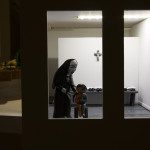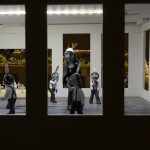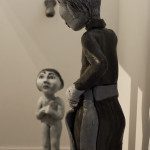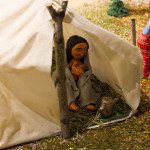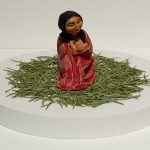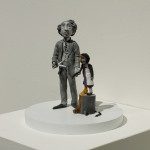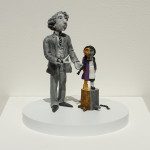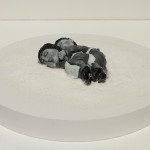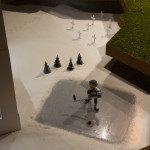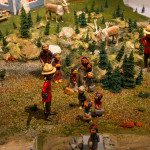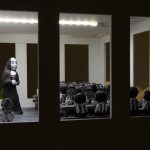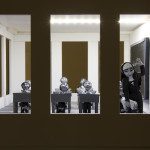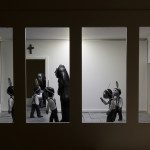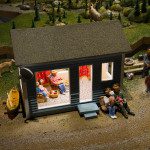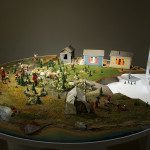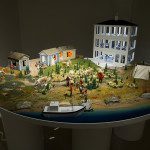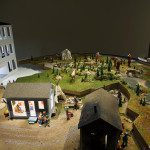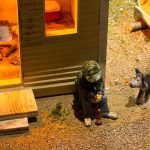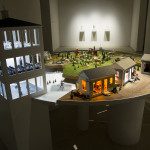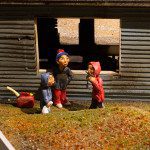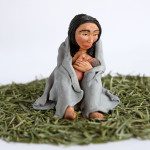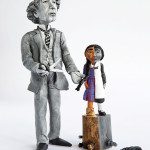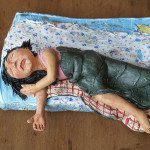Opening reception: Saturday, March 5th from 3-5pm
Karine Giboulo: Broken Circle
Text by Sasha Gora
Shoulders shrugged, a man stands among row after row of empty single beds. Like the beds, with frames that tilt and mattresses that hang a bit too far to the right, his posture is wobbly, a little unsure. It is hard to tell if he is looking ahead, or if his gaze is cast down. Part of Karine Giboulo’s Broken Circle, the empty beds are haunting as they reference the history of residential schools. The man’s stare suggests the weight of memory, the burden of stories.
Giboulo employs sculpture as a mode of storytelling. The Montreal-based artist creates elaborate miniature worlds that are reminiscent of dioramas and ethnographic museum displays. Behind their precious scale and warm colours are harsh observations and critiques of the world’s economic and social ills. For her exhibition at Art Mûr, Giboulo delicately engages with Canada’s broken relationship with First Nations communities.
Past projects have brought Giboulo to China (All you can eat, 2008), Haiti (Democracy Village, 2012), and India (City of Dreams, 2013). Back in Canada, Giboulo realized even though she grew up close to the Manawan community, Lanaudière, she had never set foot on a reserve.
The Truth and Reconciliation Commission of Canada released a summary in 2015 that describes the residential school system as cultural genocide. “Cultural” seems to soften the punch; however, cultural genocide is a component to genocide, not a different type. The commission’s head Justice Murray Sinclair states “ . . . this is not an aboriginal problem, it’s a Canadian problem.”1 Broken Circle imparts a similar view. This is an installation about Canada.
Made by hand, Giboulo sculpts each figure with compasion and respect. The labourous process and detail she invests is testimony to her awareness of the power of stories. She conducts her research with the questions of a journalist, the field notes of an anthropologist. She reports her research with the sensibilites of a storyteller.
Broken Circle is a collection of stories. Mathias, an Innu from Natashquan and residential school survivor, generously shared his stories with the artist. Detailed vignettes jump between generations to narrate a non-linear story inspired by Mathias’, and others, words. Installed as a circle, parts are broken off. One scene bring us to the tundra. We see caribou, children and the RCMP. In another we are in a school, witnessing forced assimilation. Another brings us to a reserve. Thumb out, a young woman tries to hitch a ride. The installation is representative of the complexities of Canada’s colonial legacy and how they play out today.
“The truth about stories is that that’s all we are,” writes Thomas King.2 He also warns about their dangers: “For once a story is told, it cannot be called back. Once told, it is loose in the world. So you have to be careful with the stories you tell. And you have to watch out for the stories that you are told.” For reconciliation, we need new stories that build a stronger circle. Giboulo respects the responsibility stories command and Broken Circle shares stories that need to be told.3
1. CBC News, “Truth and Reconciliation Commission urges Canada to confront ‘cultural genocide’ or residential schools, CBC News, June 2, 2015, accessed February 4, 2016, http://www.cbc.ca/news/politics/truth-and-reconciliation-commission-urges-canada-to-confront-cultural-genocide-of-residential-schools-1.3096229.
2. Thomas King, The Truth About Stories: A Native Narrative. Minneapolis: University of Minnesota Press, 2003. 2.
3. Ibid., 10.


